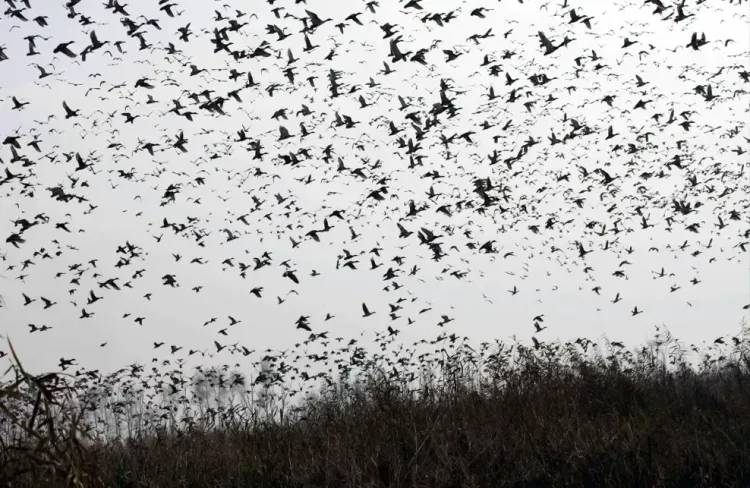When Do Migratory Birds Arrive in Kashmir for the Winter?

Synopsis
Key Takeaways
- Kashmir is a vital winter habitat for migratory birds.
- Over 600,000 birds have arrived this season.
- The Ramsar Convention plays a key role in wetland protection.
- Many bird species face threats from poaching.
- Community awareness is essential for conservation.
Srinagar, Oct 11 (NationPress) As the mountain peaks receive their initial snowfall of the season, the seasonal influx of feathered visitors to the Kashmir Valley begins a bit earlier this year.
Officials from the Wildlife Protection Department report that over 600,000 migratory birds have already settled in the Valley, seeking refuge from the harsh winter conditions of their summer habitats to enjoy the milder waters of Kashmir for the winter.
"We have welcomed more than 600,000 migratory birds thus far, and we anticipate that this figure will reach double by mid-next month," stated officials from the Wildlife Protection Department.
These birds find their winter sanctuary in various water bodies across the Valley, including wetland bird reserves like Hokersar near Srinagar, Mirgund and Hygam in Baramulla district, Shallabugh in Ganderbal, Chatlam in Pulwama, Wullar Lake, and even outside the protected reserves like Dal Lake and other large water bodies.
Around 22 species of migratory birds travel from their summer habitats in regions such as China, Siberia, Central Asia, and Eastern Europe to spend their winters in Kashmir.
The majority of these species include Gadwalls, Wigeons, Shovellers, Pintails, Mallards, Tufted Ducks, Ruddy Shelducks, Greylag Geese, Smews, Grebes, Cormorants, and Sandhill Cranes.
Among them, Greylag Geese are the last to arrive, while Cormorants and Sandhill Cranes are known for their migratory habits, spending a limited time in the Valley before continuing to the Indian plains for winter and then returning to their summer habitats in spring.
The extensive journey of these migratory birds, covering thousands of miles between their summer and winter homes, is a remarkable feat of aerial navigation unmatched in the animal kingdom.
These birds navigate their flight by using the sun during the day, the stars at night, and the geomagnetic field whenever necessary.
Some species have the ability to perceive polarized light, which many migratory birds may utilize for nighttime navigation.
The leader of the flock is typically the oldest bird, who is familiar with the migratory route.
If the leader cannot continue for any reason, the next bird in line takes over.
Each species of migratory birds travels in a distinct manner, adhering to the saying, birds of a feather flock together.
Thus, teals, Mallards, Wigeons, Shovellers, Ruddy Shelducks, Pintails, and Pochards maintain separate flights.
Given that migratory birds face the highest risk of extinction, an international environmental treaty on wetland protection known as the Ramsar Convention was signed in 1971.
This treaty aims to promote conservation and sustainable use of wetlands, vital for biodiversity and sustainable development.
Named after the Iranian city where it was established, it provides a framework for both national and international collaboration, designating certain wetlands as being of global significance, known as Ramsar Sites, for their ecological character, hydrological functions, or wildlife value.
In Jammu and Kashmir, there are five Ramsar sites, including Hokersar, Shallabugh, Wullar Lake, and Hygam in the Valley, along with Mansar-Surinsar Lake in the Jammu division.
As the wetlands, particularly the protected bird reserves, thrive with the arrival of migratory birds in Kashmir, villagers surrounding these wetlands begin to hear the lively sounds of migratory birds and witness a vibrant display of colors in the night sky.
The duck tales that recount the stories of the arrival and endurance of these resilient beings once formed an integral moral narrative of the Valley, passed down from family elders to younger generations.
While these duck tales have faded into history as children now access digital lessons and history early on, the wonder of migratory birds remains an inseparable aspect of our heritage.
Despite stringent anti-poaching laws in Jammu and Kashmir, threats to migratory birds from poachers persist.
Unscrupulous poachers are often seen covertly selling the birds during the winter months.
However, the Wildlife Protection Department's watch and ward staff have reduced the threat of poaching.
Poachers' weapons are confiscated, and offenders face trials in the courts.
Unless society recognizes that coexistence is the only sustainable path for humanity, migratory birds will continue to face an elevated risk of extinction globally.









